Installing a lock in an interior door is not particularly difficult, but it has a number of features, without which it is impossible to successfully complete this procedure. It is necessary to initially decide on the functionality and design of the locking mechanism so that it fully corresponds to its purpose and interior.
Varieties of door locks
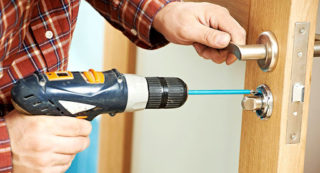
For premises of different functionality - bedrooms, kitchens, bathrooms, closets, change houses - locks with varying degrees of reliability are needed.
Varieties of door locks:
- Faley (latch). It is the simplest device designed to keep the web closed. The opening mechanism consists of a cylinder, a spring and a tongue.
- Latch with a lock. Modification of the lamellar type product. A lock installed on the inside of the room blocks the rotation of the handle. There are push-button and lever models on sale with or without opening from the outside.
- Magnetic. Consists of deadbolt, magnet and striker. The sash is held by pulling the steel bolt to the magnet. The contact of the parts is strong enough so that the door cannot be opened by wind or draft. The device, although silent, is rather bulky and does not fit into every interior.
- Mortise. Installed inside the canvas. Consists of a body, a cylinder (larva) and a striker. Can be used separately from the handle. Locks of this type are used to block the entrance to rooms where valuable or dangerous things are stored, as well as rooms in apartments where several families live.
- Espagnolette. It is mainly used to fix one of the leaves in a double system. It can be used in the bathroom as an addition to the usual latch. The mechanism is simple and reliable; installation takes a few minutes.
- Latch. The product is installed on the inner side of the canvas. Serves to be closed in a room, toilet and bathroom. It is a body, inside of which a plate or cylinder moves. Used as a complement to non-locking latches or regular overhead handles.
- Suvaldny. Locking devices of this type have the highest degree of protection against unauthorized opening. They are used to duplicate the entrance locks on the doors in the rooms in which valuables are stored. Inside the body there are plates (levers), to which only a key with a certain bit profile is suitable.
- Overhead. The models are available in manual and automatic versions. All parts are mounted on the surface of the fragments of the entrance group. Such a solution cannot be called elegant, but it is quite suitable for storerooms, panel rooms and boiler rooms. Products with a modern design will fit into any, even sophisticated environment.
Designers recommend equipping an apartment with locks of the same type in order to achieve beauty and harmony in this regard.
Features of choice
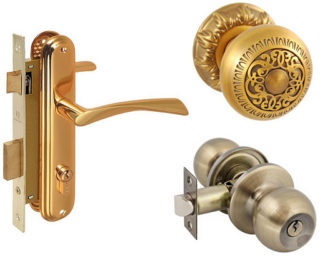
Recommendations for choosing a lock depending on the material of the door:
- Solid wood. Such canvases are expensive, but presentable and functional. Due to the strength and toughness of the tree, all types of fasteners are firmly and reliably held in it. There are no restrictions on the type of locks; locking products of any type and size can be used.But it should be remembered that wood absorbs moisture, which is transferred to the metal. It is worth choosing products with an anti-corrosion coating or stainless steel.
- Plastic. The canvases are a frame on which thin plates with a textured surface are glued. It is not suitable as a basis. Installation of light internal locks is allowed. It makes no sense to install powerful products, since the door is easy to break even without the help of tools.
- Glass. Since the thickness of the panels does not exceed 10 mm, the choice is limited only by patch locks. It is necessary to think in advance about the order of making holes and installing decorative parts. It is advisable to give the dimensions to the manufacturer. If this is not possible, purchase a special diamond drill.
- Chipboard. In the massif, pressed shavings do not differ in sufficient strength, self-tapping screws do not hold well in them. Based on this, the option is only possible with internal mechanisms. Overhead devices can be used provided they are bolted through. In this case, you will have to think about how to effectively close their hats.
When deciding on the choice of a locking device, you need to think about the future. In all cases, you will have to make several holes to insert it. It will not be possible to completely disguise them after replacing them with another product. Therefore, you need to make a lock on the door so that it serves no less than the entrance group itself. Another option would be to purchase a product similar in design.
Required tools and materials
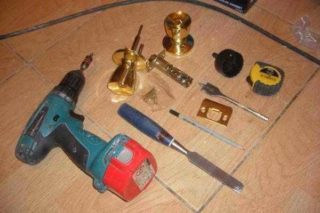
It is possible to install a lock in an interior door at any stage of the building's operation, but it is better to wait until the process of its shrinkage is over.
To install the locking device, you will need a set consisting of the following devices:
- screwdriver with drilling mode;
- roulette;
- ruler;
- square;
- chisels;
- awl;
- knife;
- a hammer;
- pencil;
- masking tape.
As a rule, hardware is included with the product. If something is lost during storage, you can buy it in any hardware store.
In order not to get injured while working, you will need to purchase construction glasses and gloves.
Preparation and markup
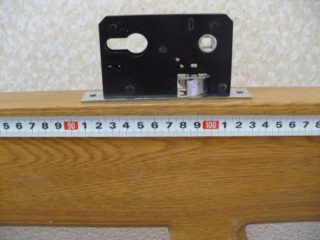
Do-it-yourself insertion of a lock into an interior door has the following sequence of actions:
- Remove from the workplace all objects that may interfere with installation or scratch the canvas.
- At a height of 90-110 cm, draw a line on the end of the sash. Paste this place around with masking tape on both sides. This will make it easier to mark and prevent scratches on the sash.
- In accordance with the diagram attached to the product, transfer the drilling and sampling points to the end face and the canvas in accordance with the indicated dimensions.
After finishing the marking, you should once again carefully check the correctness of its application. An error can lead to damage, breakdown of the mechanism or its incorrect operation.
Features of installing a lock in an interior door with your own hands
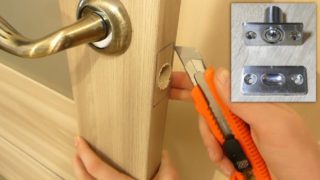
With the right approach, it will not be difficult to embed the lock. It is necessary to forget about haste, be attentive and maximally focused on each action performed.
Insert the inner lock according to the following step-by-step instructions:
- Drill through holes for the handles. First you need to make a recess with an awl so that the drill does not slip to the side. You need to make holes alternately on each side until they meet inside the canvas. So their edges will be even and smooth.
- Make an opening for the lock body. This can be done only with a chisel, but it is advisable to first use a drill with a drill on wood. A chain of holes is made at a distance of 10 mm. The remaining material is removed with a chisel. The walls of the opening are brought to the desired condition with a knife.
- Insert the housing into the socket, outline the outline of the support strip. Measure its thickness and carefully make a corresponding indentation with a chisel.Adjust the product vertically and horizontally. If a little more wood has been removed, place a few wood chips under the plank. Screw on the body with self-tapping screws.
- Install the handles. They can be separate or combined, it depends on the chosen design of the mechanism. The handles should hold tightly in the body, without distortions and backlash.
- If a larva is provided, insert it into the hole, placing it exactly in the middle. Then fix with the bolt, not overtightening, so as not to deform the insert. Check the correct operation of the larva, cover it with decorative overlays.
- Marking the mating part of the device. Here you should not rely on measurements and numbers, it is better to use direct projection. To do this, a little pencil lead is applied to the lock tongue and the broom is applied to the door frame. A clear trace remains, which is used as a guide for the location of the plank.
- Mounting the striker. Two contours are applied to the jamb - inner and outer. The first one deepens so that the tongue can enter it without resting on the bottom. The second is just enough to sink the product flush with the frame surface. The deeper hole will be partially visible. So that it does not catch the eye, it is advisable to clean out its edges and paint them to match the color of the frame. After the paint has dried, you can screw on the bar.
- Check the correct operation of the locking device. If there is a backlash, you need to gently lift the protruding strip on the counterpart with pliers.
In order for the lock to serve for a long time and not have to change it a couple of years after installation, the mechanism of the device must be periodically serviced. This procedure is simple and will not take much time. It consists in tightening loose fasteners, cleaning parts from dirt and replacing grease.








